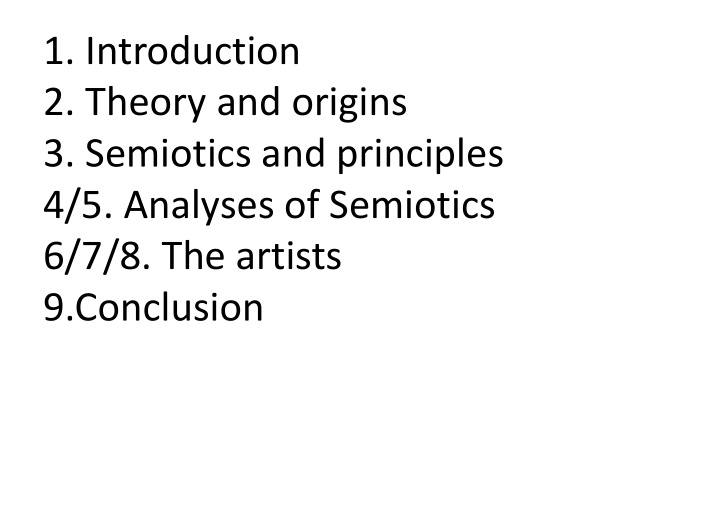



1. Introduction 2. Theory and origins 3. Semiotics and principles 4/5. Analyses of Semiotics 6/7/8. The artists 9.Conclusion
Roland Barthes, the French Structuralist critic and semiotician ‘recognized that everything in culture could be decoded - not just literature but fashion, wrestling, strip tease, steak and chips, love, photography and even Japan Incorporated’. Q What are semiotics and how do Barthes ideas help in understanding painting today?
Roland Barthes and Structuralism Roland Barthes was a French literary theorist, philosopher, critic, semiotician. Member of the Structuralist movement that developed in France in the 1950’s and 60’s. Structuralist ideology was concerned with the study of human culture, society and language through semiotics.
In this essay I am going to discuss some of the principles behind Semiotics and discuss the work of Alice Neel, Elizabeth Peyton, Chantal Joffe and Paula Rego Alice Neel Elizabeth Peyton Chantal Joffe Paula Rego
Semiotics is the study of signs It tries to explain how our interpretations of images work and acknowledges linguistics as a means of articulating them. It translates signs into words which leads to the construction of concepts. The word ‘Rose’ T he visual object or The concept/ meaning Semiotics calls the sound of the word that we understand Semiotics calls this from looking at roses is this the ‘ sign ’ the ‘ signifier ’ ‘true love’. Semiotics calls this the ‘ signified ’
Signs can be…. Objects, words, images, colours, sounds. Odours, flavours, textures. Gestures, facial expressions, emotions. Signs are ways that we communicate information. Every picture tells a story
Signs make you see.... The relationship of one image to another image. eg: child, man and woman The connections of the image to a concept. eg: is this a family unit? daughter, father, mother. Why does the child look withdrawn and unhappy? Neel, A. (1970) The Family (John Gruen, Jane Wilson and Julia) Museum of Fine Arts, (2010) Alice Neel Painted Truths. Houston
Signs make you see.... The context within which the image is being used. eg: the time the painting is set in and who is viewing it. Whether it relates to the viewers life experiences and interests. Are you interested in the young princes? Where were they going? You associate them with the death of their mother. Peyton, E. (1999) Prince Harry and Prince William. New Museum (2000) Live Forever. New York
Signs make you see.... That an image in a painting can be combined with other images to produce a new concept. eg: naked woman and baby in a nappy, on a tiled floor and a blank wall. Possibly Madonna and child. The child is struggling and does not want to be controlled. The blank wall is a blank canvas for them to create their new relationship. Joffe, C. (2005) Mother and Child II in www.victoria-miro.com
Signs make you see.... What is being said? Who it is being said to? Who is saying it? Why it is being said? This all adds to gaining an understanding of the concept and meaning within a picture and leads to so much more! Rego, P. (2006) The Aunt in www.marlboroughfineart.com
Recommend
More recommend